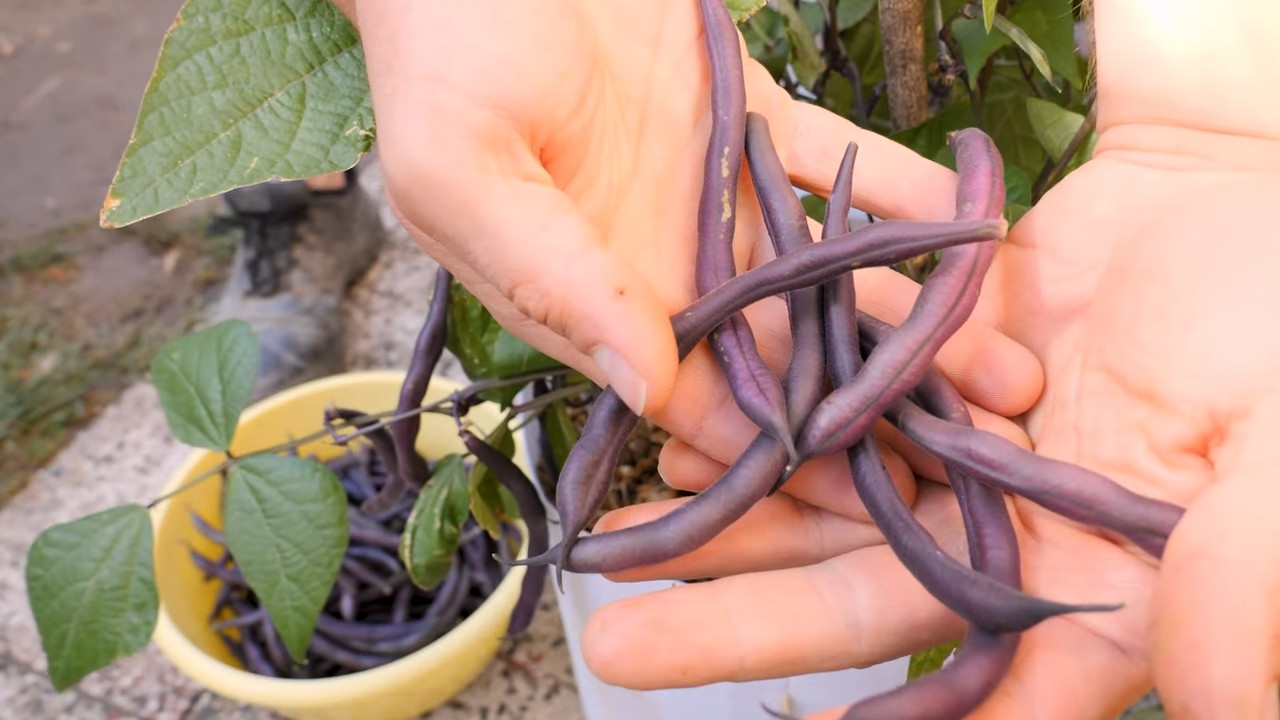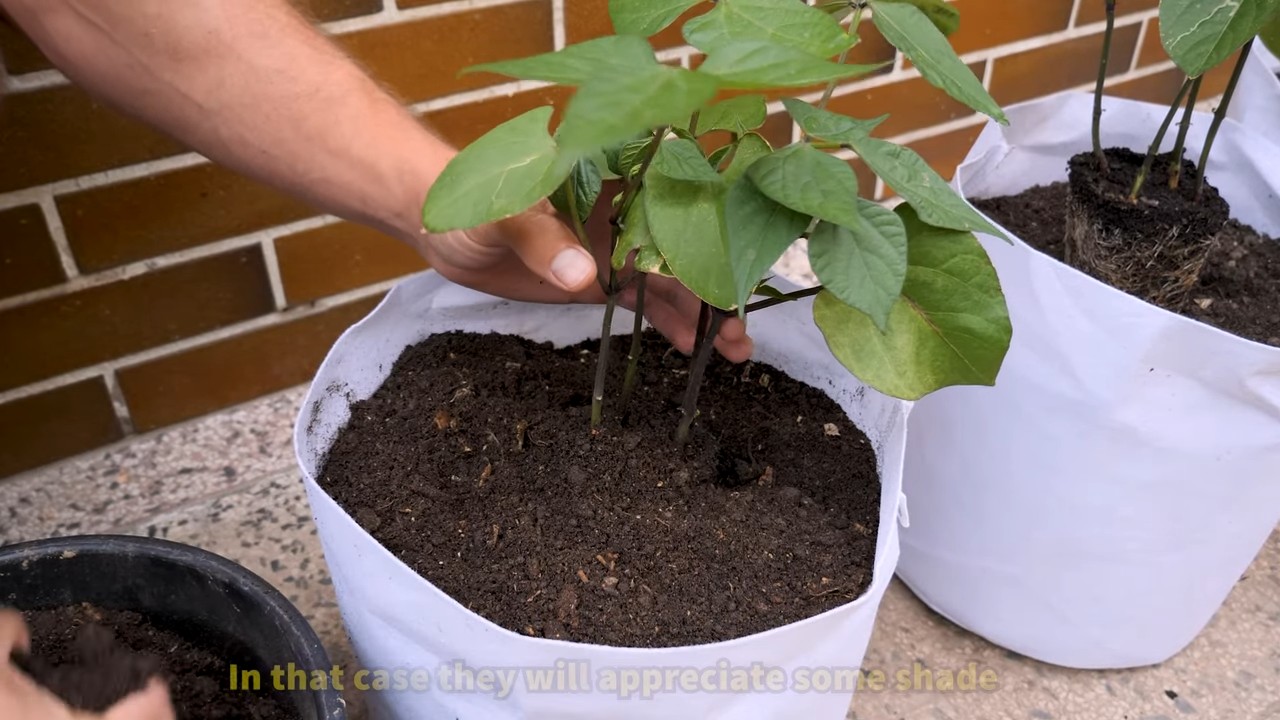Purple bush beans container gardening is easier than you think, and I’m here to show you how! Have you ever dreamt of stepping outside your door and harvesting vibrant, delicious purple beans for your dinner? Imagine the satisfaction of knowing exactly where your food comes from and the joy of sharing your homegrown bounty with friends and family.
For centuries, growing your own food has been a cornerstone of self-sufficiency and a connection to the earth. While large-scale agriculture has become the norm, the tradition of home gardening, especially in containers, is experiencing a vibrant resurgence. It’s a way to reconnect with nature, reduce our carbon footprint, and enjoy the unparalleled flavor of freshly picked produce.
But let’s be honest, not everyone has acres of land or the time for extensive gardening. That’s where the magic of container gardening comes in! And that’s why you need this DIY guide. Growing purple bush beans container style is perfect for small spaces, balconies, or even just a sunny windowsill. Plus, it’s a fantastic way to introduce kids to the wonders of gardening. This article will provide you with simple, effective DIY tricks and hacks to ensure a bountiful harvest of beautiful purple bush beans, even if you’re a complete beginner. So, grab your gardening gloves, and let’s get started!

Growing Purple Bush Beans in Containers: A Complete DIY Guide
Hey there, fellow gardening enthusiasts! I’m so excited to share my experience with growing purple bush beans in containers. It’s a surprisingly easy and rewarding project, even if you’re short on space. Plus, those vibrant purple beans are just gorgeous! This guide will walk you through every step, from choosing the right container to harvesting your delicious crop. Let’s get started!
Choosing the Right Container and Soil
Before we even think about seeds, we need to set the stage for success. The right container and soil are crucial for healthy bean plants.
* Container Size: Bush beans don’t need a ton of space, but they do need enough room for their roots to spread. I recommend a container that’s at least 12 inches in diameter and 12 inches deep. A 5-gallon bucket works perfectly!
* Drainage: This is non-negotiable! Make sure your container has drainage holes. Beans hate sitting in soggy soil, which can lead to root rot. If your container doesn’t have holes, you can easily drill some.
* Material: Plastic, terracotta, or even fabric pots all work well. I personally prefer plastic because they retain moisture better, but terracotta looks beautiful.
* Potting Mix: Don’t use garden soil! It’s too heavy and compacts easily in containers. Instead, opt for a high-quality potting mix. Look for one that’s well-draining and contains ingredients like peat moss, perlite, or vermiculite. You can also make your own by mixing equal parts of these ingredients.
Planting Your Purple Bush Beans
Now for the fun part – planting!
1. Gather Your Supplies: You’ll need your container, potting mix, purple bush bean seeds (I love the ‘Royal Burgundy’ variety!), a trowel, and water.
2. Fill the Container: Fill your container with potting mix, leaving about an inch or two of space at the top.
3. Sow the Seeds: Plant the seeds about 1 inch deep and 2-3 inches apart. I usually plant 3-4 seeds per container, just in case some don’t germinate.
4. Water Gently: Water the soil gently until it’s evenly moist but not soggy.
5. Find a Sunny Spot: Bush beans need at least 6-8 hours of sunlight per day. Place your container in a sunny location, like a patio, balcony, or even a sunny windowsill.
Caring for Your Purple Bush Bean Plants
Once your seeds have sprouted, it’s time to provide them with the care they need to thrive.
* Watering: Keep the soil consistently moist, but not waterlogged. Water deeply when the top inch of soil feels dry to the touch. Avoid watering the foliage, as this can encourage fungal diseases. I usually water in the morning so the leaves have time to dry out during the day.
* Fertilizing: Bush beans are relatively light feeders, but they’ll benefit from a little boost. I like to use a balanced liquid fertilizer (like a 10-10-10) diluted to half strength every 2-3 weeks. You can also add some compost tea to the soil for extra nutrients.
* Support: While bush beans are generally self-supporting, they can sometimes flop over if they get too heavy with beans. You can provide some support by placing a small tomato cage or a few stakes around the plants.
* Pest Control: Keep an eye out for common bean pests like aphids, bean beetles, and spider mites. You can usually control these pests with insecticidal soap or neem oil. I prefer to use organic methods whenever possible.
* Weeding: Keep the container free of weeds, as they can compete with your bean plants for nutrients and water.
Dealing with Common Problems
Even with the best care, you might encounter a few problems along the way. Here are some common issues and how to address them:
* Yellowing Leaves: This can be caused by overwatering, underwatering, nutrient deficiencies, or pests. Check the soil moisture and adjust your watering accordingly. If the soil is dry, water deeply. If it’s soggy, let it dry out before watering again. If the yellowing is accompanied by stunted growth, consider fertilizing with a balanced fertilizer.
* Lack of Flowers: This can be caused by insufficient sunlight, over-fertilizing with nitrogen, or high temperatures. Make sure your plants are getting enough sunlight. Avoid using fertilizers that are high in nitrogen, as this can promote leafy growth at the expense of flowers. If the weather is too hot, try to provide some shade during the hottest part of the day.
* Bean Beetles: These pesky beetles can quickly decimate your bean plants. Handpick them off the plants and drop them into a bucket of soapy water. You can also use insecticidal soap or neem oil.
* Powdery Mildew: This fungal disease can cause a white, powdery coating on the leaves. Improve air circulation by spacing your plants further apart. You can also treat powdery mildew with a fungicide.
Harvesting Your Purple Bush Beans
The moment we’ve all been waiting for – harvesting!
1. Timing is Key: Bush beans are usually ready to harvest about 50-60 days after planting. The beans should be firm and plump, but not bulging. They should also snap easily when bent.
2. Harvest Regularly: Harvest your beans every few days to encourage continued production. If you let the beans get too large, the plants will stop producing new beans.
3. How to Harvest: Gently snap the beans off the plant, being careful not to damage the stems.
4. Enjoy Your Harvest: Purple bush beans are delicious steamed, sautéed, or added to salads. They’re also a great source of vitamins and fiber.
Extending Your Harvest
Want to keep those purple beans coming? Here are a few tips for extending your harvest:
* Succession Planting: Plant a new batch of seeds every 2-3 weeks to ensure a continuous supply of beans.
* Deadheading: Remove any spent flowers or beans to encourage the plant to produce more.
* Water Consistently: Consistent watering is crucial for continued production.
* Fertilize Regularly: Continue to fertilize your plants every 2-3 weeks to provide them with the nutrients they need.
Saving Seeds (Optional)
If you want to save seeds from your purple bush beans for next year, here’s how:
1. Let Some Beans Mature: Allow a few beans to mature on the plant until they are dry and brown.
2. Harvest the Dry Beans: Remove the dry beans from the pods.
3. Dry the Seeds: Spread the seeds out on a tray and let them dry completely for a few weeks.
4. Store the Seeds: Store the dried seeds in an airtight container in a cool, dark, and dry place.
Troubleshooting: Why Aren’t My Beans Producing?
Sometimes, despite our best efforts, our bean plants might not produce as many beans as we’d hoped. Here are some common reasons and how to fix them:
* Lack of Sunlight: As mentioned earlier, beans need at least 6-8 hours of sunlight per day. If your plants aren’t getting enough sun, try moving them to a sunnier location.
* Poor Pollination: While bush beans are self-pollinating, sometimes they need a little help. You can gently shake the plants to help release pollen.
* High Temperatures: Extreme heat can inhibit bean production. If the weather is consistently hot, try to provide some shade during the hottest part of the day.
* Over-Fertilizing with Nitrogen: Too much nitrogen can promote leafy growth at the expense of flowers and beans. Use a balanced fertilizer or one that’s lower in nitrogen.
* Pests and Diseases: Pests and diseases can weaken your plants and reduce their productivity. Keep an eye out for common bean pests and diseases and take action to control them.
Choosing the Right Variety
While I mentioned ‘Royal Burgundy’ earlier, there are other fantastic purple bush bean varieties to consider!
* ‘Purple Queen’: This is another popular variety known for its high yields and excellent flavor.
* ‘Amethyst’: This variety produces long, slender purple beans that are perfect for salads.
* ‘Dragon Tongue’: While technically a wax bean, ‘Dragon Tongue’ has beautiful purple streaks and a delicious buttery flavor.
Creative Container Ideas
Don’t feel limited to just plain pots! Get creative with your container choices.
* Repurposed Buckets: Old buckets can be given a new life as planters. Just make sure to drill drainage holes.
* Woven Baskets: Line a woven basket with plastic before filling it with soil to prevent it from rotting.
* Old Tires: Stack old

Conclusion
So, there you have it! Growing your own purple bush beans in containers is not just a gardening project; it’s a gateway to fresher, more flavorful meals, a sustainable lifestyle, and a rewarding connection with nature. We’ve walked you through the simple steps, from selecting the right container and soil to nurturing your plants and harvesting those vibrant, delicious beans.
Why is this DIY trick a must-try? Because it empowers you to control the quality of your food, reduce your carbon footprint, and enjoy the unparalleled taste of homegrown produce. Store-bought beans simply can’t compare to the crispness and sweetness of freshly picked purple bush beans. Plus, the visual appeal of these purple beauties adds a touch of elegance to any dish. Imagine serving a salad bursting with these colorful gems – your guests will be impressed!
But the benefits extend beyond the plate. Gardening is a therapeutic activity that reduces stress, promotes physical activity, and fosters a sense of accomplishment. Watching your purple bush beans sprout, grow, and produce a bountiful harvest is an incredibly satisfying experience. It’s a reminder of the simple joys in life and the power of nature.
Ready to take your container gardening to the next level? Consider these variations and suggestions:
* **Succession Planting:** Plant new seeds every few weeks to ensure a continuous harvest throughout the growing season.
* **Companion Planting:** Plant basil, marigolds, or nasturtiums alongside your purple bush beans to deter pests and attract beneficial insects.
* **Vertical Gardening:** If space is limited, try using a trellis or other support structure to train your bean plants to grow vertically.
* **Different Varieties:** Experiment with different varieties of bush beans, such as ‘Royal Burgundy’ or ‘Purple Queen,’ to find your favorite.
* **Seed Saving:** Save seeds from your best-performing plants to grow your own purple bush beans year after year. This is a great way to become more self-sufficient and preserve heirloom varieties.
Don’t be intimidated if you’re a beginner gardener. Growing purple bush beans in containers is a forgiving and rewarding project. With a little care and attention, you’ll be harvesting a delicious crop in no time.
We encourage you to give this DIY trick a try and share your experience with us! Post photos of your container gardens, share your favorite recipes using purple bush beans, and let us know what you’ve learned along the way. Your insights and experiences can inspire others to embark on their own gardening adventures.
So, grab your containers, soil, and seeds, and get ready to enjoy the bounty of your own homegrown purple bush beans. Happy gardening!
Frequently Asked Questions (FAQ)
What size container is best for growing purple bush beans?
A container that is at least 12 inches in diameter and 12 inches deep is ideal for growing purple bush beans. This provides enough space for the roots to develop properly and allows for adequate drainage. You can use larger containers if you prefer, but avoid using containers that are too small, as this can stunt the growth of your plants. Each plant needs at least 6 inches of space to thrive.
What type of soil should I use for growing purple bush beans in containers?
Use a well-draining potting mix that is specifically formulated for container gardening. Avoid using garden soil, as it can become compacted in containers and hinder drainage. A good potting mix will provide the necessary nutrients and aeration for healthy root growth. You can also amend your potting mix with compost or other organic matter to improve its fertility and water-holding capacity.
How often should I water my purple bush beans?
Water your purple bush beans regularly, especially during hot, dry weather. The soil should be kept consistently moist, but not waterlogged. Check the soil moisture by sticking your finger into the soil about an inch deep. If the soil feels dry, it’s time to water. Water deeply, allowing the water to drain out of the bottom of the container. Avoid watering the foliage, as this can promote fungal diseases.
How much sunlight do purple bush beans need?
Purple bush beans need at least 6-8 hours of sunlight per day to thrive. Choose a location for your containers that receives plenty of direct sunlight. If you live in a hot climate, you may need to provide some afternoon shade to prevent the plants from overheating.
How do I fertilize my purple bush beans?
Fertilize your purple bush beans every 2-3 weeks with a balanced fertilizer that is specifically formulated for vegetables. Follow the instructions on the fertilizer label carefully. Avoid over-fertilizing, as this can burn the roots of your plants. You can also use organic fertilizers, such as compost tea or fish emulsion.
When should I harvest my purple bush beans?
Harvest your purple bush beans when the pods are about 4-6 inches long and still tender. The beans should be plump but not bulging. Harvest regularly to encourage continued production. Use scissors or pruning shears to cut the beans from the plant, being careful not to damage the stems.
What are some common pests and diseases that affect purple bush beans?
Common pests that affect purple bush beans include aphids, bean beetles, and spider mites. Common diseases include powdery mildew, rust, and bean mosaic virus. Inspect your plants regularly for signs of pests or diseases. If you find any problems, take action immediately to control them. You can use insecticidal soap or neem oil to control pests, and fungicides to control diseases. Proper watering and ventilation can also help prevent diseases.
Can I grow purple bush beans indoors?
While it’s possible to grow purple bush beans indoors, it can be challenging. They require a lot of sunlight, so you’ll need to provide supplemental lighting. You’ll also need to ensure that they have adequate ventilation and humidity. It’s generally easier to grow purple bush beans outdoors in containers.
How long does it take for purple bush beans to mature?
Purple bush beans typically mature in 50-60 days from planting. However, this can vary depending on the variety, growing conditions, and climate.
Are purple bush beans more nutritious than green beans?
Purple bush beans contain anthocyanins, which are antioxidants that give them their purple color. These antioxidants have been linked to various health benefits, such as reducing the risk of heart disease and cancer. While both purple and green beans are nutritious, purple bush beans offer an extra boost of antioxidants.
Can I save seeds from my purple bush beans?
Yes, you can save seeds from your purple bush beans. Allow some of the pods to dry completely on the plant. Once the pods are dry and brittle, remove the seeds and store them in a cool, dry place. Be sure to label the seeds with the variety and date.
What can I do if my purple bush beans are not producing beans?
There are several reasons why your purple bush beans may not be producing beans. Make sure they are getting enough sunlight, water, and nutrients. Also, check for pests or diseases that may be affecting their growth. If the weather is too hot or too cold, this can also affect bean production. Finally, make sure you are harvesting the beans regularly to encourage continued production.




Leave a Comment